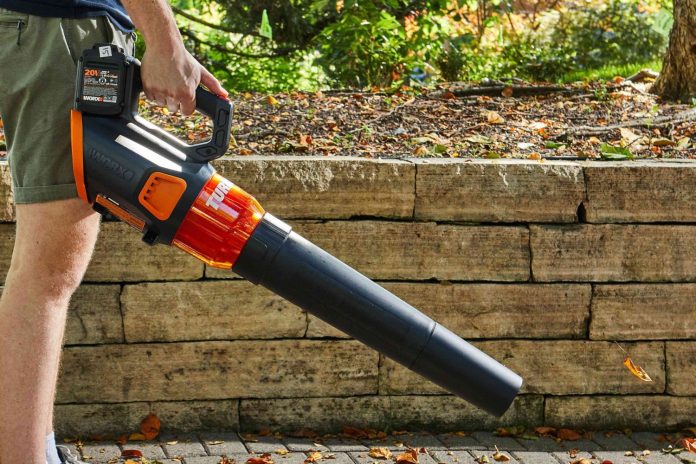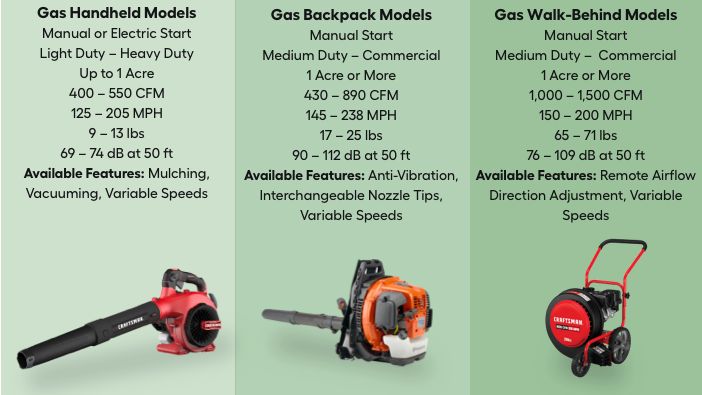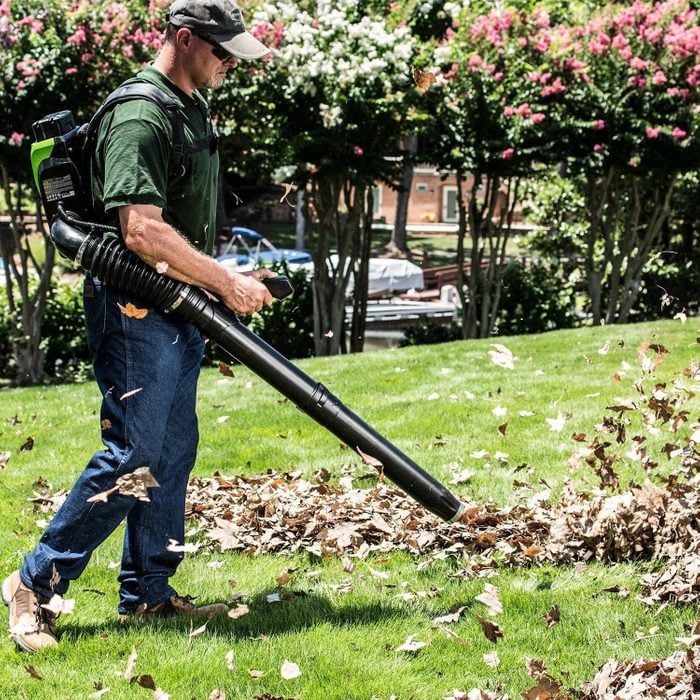Are you tired of spending hours raking leaves and debris in your yard? Look no further than a suitable leaf blower to make your life easier.
But with so many options, how do you know which one fits you best?
This article will explore the key features you should look for in a suitable leaf blower, allowing you to make an informed decision and breeze through your yard work in no time.
Say goodbye to sore muscles and hello to effortless leaf cleanup!
Power Source
When it comes to the power source of a leaf blower, you have a few options: electric, gas-powered, and battery-operated.
Electric
Electric leaf blowers are a popular choice for many homeowners. They are powered by electricity and usually require an extension cord plugged into an electrical outlet. Electric blowers are generally quieter than gas-powered models and produce zero emissions, making them an environmentally friendly option. They are also lightweight and easy to maneuver, making them ideal for small to medium-sized yards.
Gas-powered
Gas-powered leaf blowers are known for their powerful performance and are ideal for larger yards or commercial use. They often come with engines ranging from 2-stroke to 4-stroke, providing a significant amount of airflow capacity.
Gas blowers are portable and do not require an electrical outlet, making them versatile. However, they tend to be louder and produce emissions, so they may not be suitable for quieter or more eco-friendly options.
Battery-operated
For those looking for a cordless and portable option, battery-operated leaf blowers are a great choice. These blowers are powered by rechargeable batteries, allowing you to move freely without the hassle of cords or gas refills.
The battery life varies depending on the model, but advancements in battery technology have made them increasingly powerful and longer-lasting. Battery-powered blowers provide the convenience of a gas-powered blower without the noise or emissions.
Airflow Capacity
The airflow capacity of a leaf blower is crucial as it determines how effectively it can clear leaves and debris from your yard. Two standard measurement units determine airflow capacity: miles per hour (mph) and cubic feet per minute (CFM).
Miles per hour (mph)
Miles per hour (mph) measures the speed at which the air exits the blower’s nozzle. A higher mph rating indicates a more vigorous and more forceful airflow that can effectively move heavy leaves and debris. Look for leaf blowers with mph ratings above 150 for optimal performance.
Cubic feet per minute (CFM)
Cubic feet per minute (CFM) measures the volume of air the blower can move in one minute. A higher CFM rating means the blower can move a larger air volume, making it more efficient at clearing large areas or piles of leaves. Look for leaf blowers with CFM ratings above 350 for effective leaf blowing.
When considering airflow capacity, finding a balance between mph and CFM is crucial. A blower with a high mph but low CFM may provide intense bursts of air but not effectively move debris, while a blower with a high CFM but low mph may move a large volume of air but lack the necessary force to clear heavy leaves.
Noise Level
Nobody wants to be bothered by excessive noise while using a leaf blower, especially if you live in a quiet neighborhood or have noise restrictions. The noise level of a leaf blower is measured in decibels (dB), and it’s essential to consider this when making your purchasing decision.
Decibels (dB)
Leaf blowers can range in noise levels from as low as 50 dB up to 100 dB or more. As a reference, a conversation at an average volume is typically around 60 dB, and anything above 85 dB is considered loud and can potentially cause hearing damage with prolonged exposure.
If noise concerns you, look for leaf blowers with lower dB ratings. Many manufacturers now offer models with “quiet operation” features, specifically designed to minimize noise levels without sacrificing performance. These features include insulated housing, noise-reducing designs, and sound-dampening technology.
Weight and Portability
Leaf blowers come in various sizes and weights, so it’s essential to consider their portability. You may prefer a lightweight and easily maneuverable blower, depending on your needs.
Lightweight design
A lightweight blower is an excellent option if you have a smaller yard or only need to clear leaves from a specific area. Lightweight blowers are usually electric or battery-operated and are designed with user comfort in mind. They are easier to handle, minimize fatigue, and allow longer work sessions without straining your arms or shoulders.
Portable features
Portability is vital for those with larger yards or professional landscapers who need to cover more ground-tical. Look for leaf blowers with ergonomic handles, padded straps, or wheels. Backpack blowers are famous for their portability and comfort, distributing the weight across your shoulders and back. Walk-behind blowers, equipped with wheels and handles, are ideal for clearing larger areas quickly and efficiently.
Consider your specific needs regarding weight and portability, as finding the right balance can make a significant difference in your leaf-blowing experience.
Blower Types
Leaf blowers come in different types, each with its advantages and purposes. Understanding the different blower types will help you make an informed decision based on your specific needs.
Handheld blowers
Handheld blowers are compact and versatile, making them suitable for small to medium-sized yards or those with limited storage space. They are lightweight, easy to handle, and convenient for quick cleanups. Handheld blowers are available in electric and battery-operated options, offering a range of power and performance levels to suit your needs.
Backpack blowers
Backpack blowers are designed for extended use and larger areas. They are worn on your back, distributing the weight evenly and reducing strain on your arms and shoulders. Backpack blowers are typically gas-powered and offer more power than handheld models. They are favored by professionals and homeowners with larger yards due to their portability and ability to handle heavy-duty tasks.
Walk-behind blowers
Walk-behind blowers are the most powerful and efficient type of leaf blower. As the name suggests, they are designed to be pushed and walked behind, similar to a lawnmower. These blowers are ideal for large properties or areas with dense leaf cover.
They are typically gas-powered and offer exceptional blowing power and air volume. Walk-behind blowers often come with additional features such as adjustable speeds, height adjustments, and even self-propulsion, allowing for ease of use and maximum efficiency.
Consider the size of your yard, the type of debris you need to clear, and your physical capabilities when choosing the right blower type.
Speed Settings
Having control over the speed of your leaf blower is essential, as different tasks may require varying levels of power. Look for leaf blowers with adjustable speed settings to suit various blowing needs.
Variable speed control
Many modern leaf blowers come with variable speed control, allowing you to adjust the airflow to your desired level.
This feature benefits delicate tasks such as clearing leaves from flower beds or removing debris from fragile areas without causing damage. Variable speed control also lets you conserve battery life or fuel when dealing with lighter debris.
Multiple speed options
Some leaf blowers offer preset speed options, allowing you to choose from various speed settings for different tasks.
This feature is handy for those who prefer simplicity and want the flexibility to switch between high-speed blowing for heavy debris and low-speed blowing for precision tasks. Having multiple speed options ensures you can quickly and efficiently tackle any job.
Start Mechanism
The start mechanism of a leaf blower determines how easy it is to get it up and running. Consider your preferences and physical capabilities when choosing between different start mechanisms.
Electric start
Electric start leaf blowers are incredibly convenient as they eliminate the need for manual pulling. With the push of a button, you can quickly start your blower and get to work. Electric start models are usually found in electric or battery-operated blowers, providing hassle-free operation and reducing user fatigue.
Pull-start
Pull-start blowers are more commonly found in gas-powered models. They require pulling a cord to start the engine, similar to starting a lawnmower. While pull-start blowers are straightforward to use, some individuals may find them more physically demanding, especially if they have limited arm strength or mobility. However, recent advancements in engine technology have made pull-start mechanisms smoother and easier to operate.
Consider your preference for convenience and ease of use when deciding on the start mechanism of your leaf blower.
Build Quality and Durability
When investing in a leaf blower, you want a machine that will withstand frequent use and last for years. Consider the build quality and durability of the blower to ensure its longevity.
Sturdy construction materials
Look for leaf blowers constructed with high-quality materials such as durable plastics or metal components. A sturdy construction will protect the blower from accidental impacts, vibrations, and other potential damage during use. It’s also essential to consider the quality of the nozzle, as it is the part of the blower directly in contact with debris and the ground.
Long-lasting components
Check the specifications or reviews of the leaf blower to ensure it has long-lasting components. Please pay attention to features such as brushless motors, known for their increased durability and reduced maintenance.
Additionally, look for blowers with high-quality air filtration systems to prevent engine damage and prolong the blower’s lifespan.
Attachments and Accessories
Leafblowers often come with various attachments and accessories that can enhance their functionality and versatility. Consider the following options when choosing a leaf blower:
Nozzle attachments
Different nozzle attachments can help focus and control the airflow, enabling you to tackle various tasks more effectively. Look for blowers with attachments, such as a concentrator nozzle for precision blowing, a flare nozzle for broader coverage, or a flat nozzle for gathering debris into piles.
Vacuum and mulching capabilities
Some leaf blowers offer additional functionality, allowing you to switch between blowing and vacuuming modes. These blowers usually come with a collection bag or mulching attachments, enabling you to collect leaves and debris directly into a bag or mulch them into fine particles for more straightforward disposal or composting.
Extension cords
If you opt for an electric leaf blower, consider the length and quality of the included power cord. Alternatively, you may need a separate extension cord to ensure sufficient reach around your yard.
Price Range
Leaf blowers vary in price, and it’s essential to consider your budget when purchasing. Luckily, there are options available for every budget.
Budget-friendly options
If you’re looking for an affordable leaf blower without compromising performance, plenty of budget-friendly options are available. Electric and battery-operated blowers are often more cost-effective than gas-powered models, and they still offer sufficient power for most residential needs. Consider models from reputable brands that offer a good balance of features and affordability.
Premium models
For those looking for top-of-the-line performance and advanced features, premium leaf blowers are worth considering. These models often come with higher mph and CFM ratings, improved durability, additional accessories, and extended warranty periods. While they may have a higher price tag, premium models are designed to withstand heavy use and offer enhanced functionality for professional landscapers or those with extensive yard maintenance needs.
Consider your budget and intended usage when choosing between budget-friendly and premium models. Finding a leaf blower that fits your needs is essential without breaking the bank.
In conclusion, when looking for a suitable leaf blower, consider the power source, airflow capacity, noise level, weight and portability, blower type, speed settings, start mechanism, build quality and durability, attachments and accessories, and the price range.
By carefully considering these factors, you can find a leaf blower that suits your requirements and makes yard maintenance a breeze. Happy leaf-blowing!








































